“COMANCHE” CHOPPED OVER A DAY OFF THE TRANSATLANTIC RACORD. GREAT BOAT, GREAT CREW, BUT REMARKABLE ROUTING FROM STAN HONEY
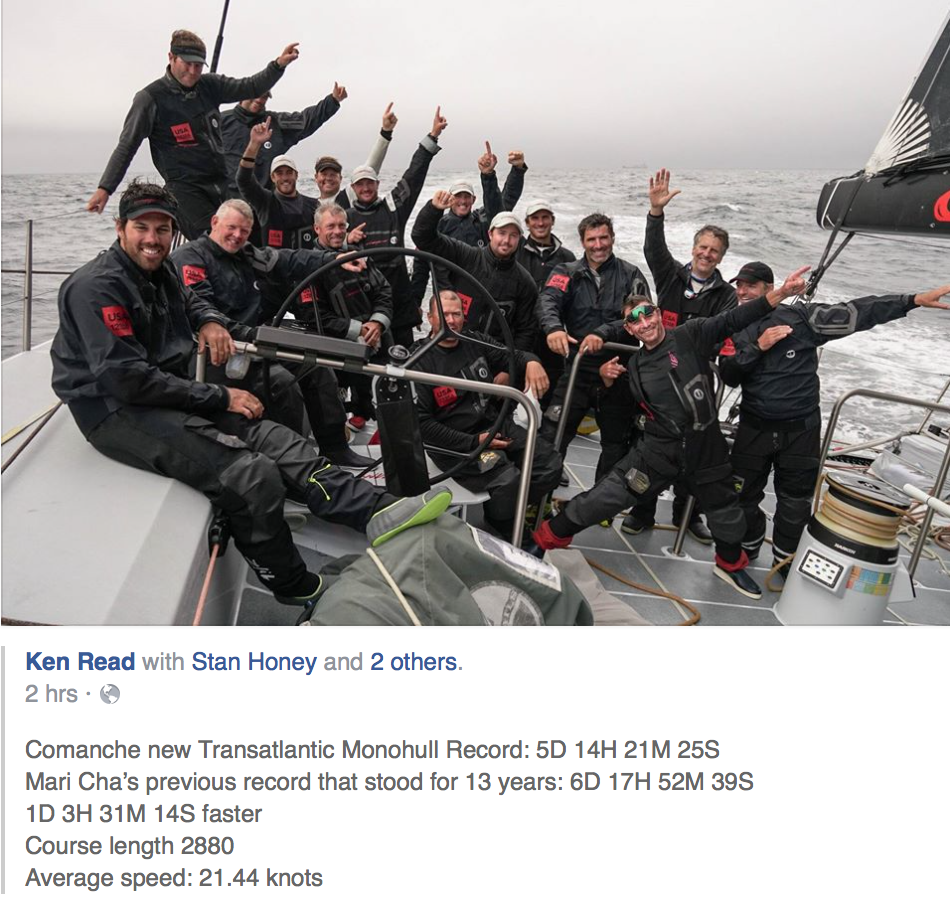
“COMANCHE” CHOPPED OVER A DAY OFF THE TRANSATLANTIC RACORD. GREAT BOAT, GREAT CREW, BUT REMARKABLE ROUTING FROM STAN HONEY

Published on July 22nd, 2016
(July 22, 2016) – Comanche, the 100 foot racing yacht owned by Jim Clark and Kristy Hinze-Clark, will depart this evening from New York (USA) and point her bow East to Britain as the record-breaking monohull takes on the Atlantic in a bid to continue breaking world records.
An exciting weather window has opened up which promises fast conditions with strong wind, great angles and flat seas all the way to Europe. With Comanche skipper Ken Read committed to TV commentating at the Louis Vuitton America’s Cup World Series in Portsmouth, England, over the weekend, the world class crew will be led by experienced sailors Casey Smith, Tony Mutter, Richard Clarke and Navigator Stan Honey. Due to other commitments, Comanche will also be missing regular crewmen Kelvin Harrap, Warwick Fluery, Jimmy Spithill and Ryan Godfrey.
North Sails President Ken Read, speaking from the America’s Cup event in the UK, said, “A fantastic weather window has opened up for Comanche to take on the Atlantic. We have been on standby for a few weeks now and have almost left on three separate occasions since the end of June, and each time we have had to piece together a different team based on who is available, before the weather fizzled out and shut down those attempts. But now the right conditions have presented themselves.
“On a personal level the timing couldn’t be worse as I am committed to my role as TV commentator for the America’s Cup and am on the wrong side of the Atlantic to jump on the boat with the crew, as are key crewmembers such as Kelvin, Jimmy, Warwick and Ryan. But that is life sometimes. It is very difficult to plan a record attempt, so different from a regatta that is scheduled on a very specific date. But this program, put together by the Clark’s, has always been about their core belief in The Team. Under the guidance of Casey, Stan and a crew boasting some of the best sailors in the world, Comanche is in perfectly good hands and if the weather cooperates, they will do it.”
Speaking ahead of the departure, Comanche owner Jim Clark stated, “Comanche was built to break records – she has already proven her potential in major events all around the world and this looks to be a great opportunity to continue her legacy. It’s a real shame her skipper Ken Read and other key crewmembers will have to miss this ride but he and I will both remain in close contact with the guys onboard. The crew is made of some of the best sailors in the world who all have great pedigree. I have a good feeling about this attempt.”
The highly experienced Navigator on Comanche, Stan Honey, identified the window of opportunity for the crew “The current weather models are giving us ideal conditions to potentially beat the record if everything develops as forecast. Whilst the patterns look perfect for now, with flat seas and a great angle with strong winds to power us across the Atlantic, as ever we are always at the mercy of changing weather, so we’ve got everything crossed. All in all now is the time to go if we are to take on the record this summer.”
The current monohull transatlantic record from West to East (Ambrose Lighthouse to Lizard Point) is 6 days 17 hours 52 minutes and 39 seconds, set by Mari Cha IV in October 2003. In 2015, Comanche set the 24 hour monohull distance record of 618 miles as they raced across the Atlantic (at an average speed of 25.75 knots).
To follow the progress of Comanche, please visit:
The boat will sail with only 17 crew and with all manual powered winches and hydraulics for this record attempt:
Casey Smith (AUS), Boat Captain
Stan Honey (USA), Navigator
Tony Mutter (NZL), Trimmer
Dirk de Ridder (NED), Main Trim
Chris Maxted (AUS), Boat Crew
Jon von Schwarz (USA), Grinder
Juggy Clougher (AUS), Bow
Julien Cressant (FRA), Pit
Nick Dana (USA), Bow
Pablo Arrarte (ESP), Runners
Pepe Ribes (ESP), Bow
Peter van Niekerk (NED), Trimmer
Phil Harmer (AUS), Grinder
Richard Clarke (CAN), Runners
Robert Greenhalgh (GBR), Main Trim
Shannon Falcone (ATG), Grinder
Yann Riou (FRA), Media
FROM SAILING SCUTTLEBUTT
No-one deserves to be nominated more than Larry Huntington. Sailor of the Month really does not justify the lifetime of Love of the Sea. Few have demonstrated a stronger commitment to sailing; particularly offshore long distance racing. His career spans wooden schooners to the latest carbon yachts.
CLICK HERE TO CAST A VOTE FOR LARRY.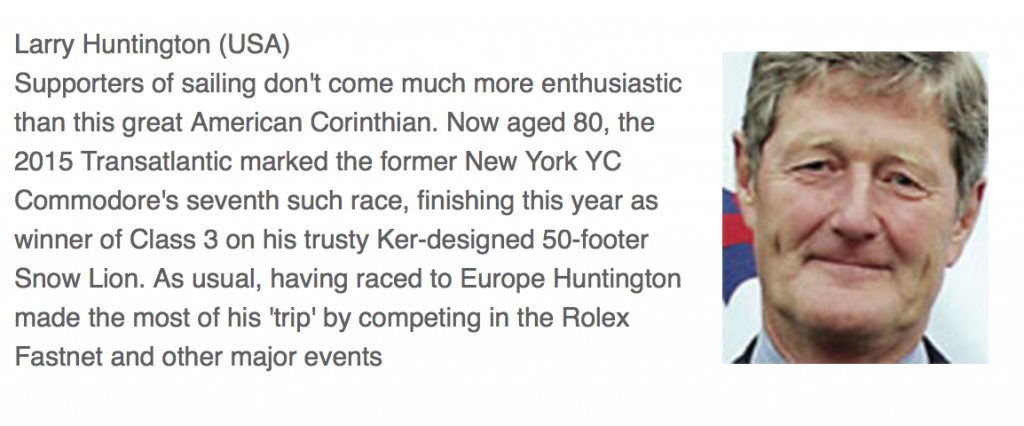

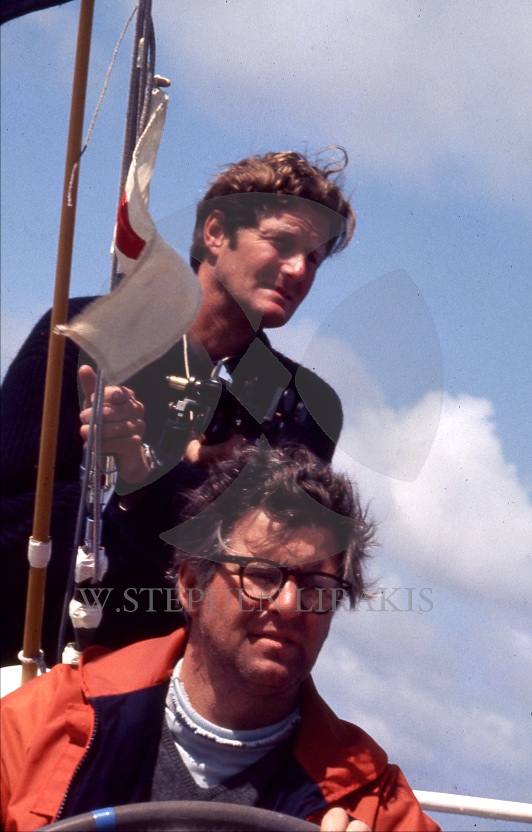
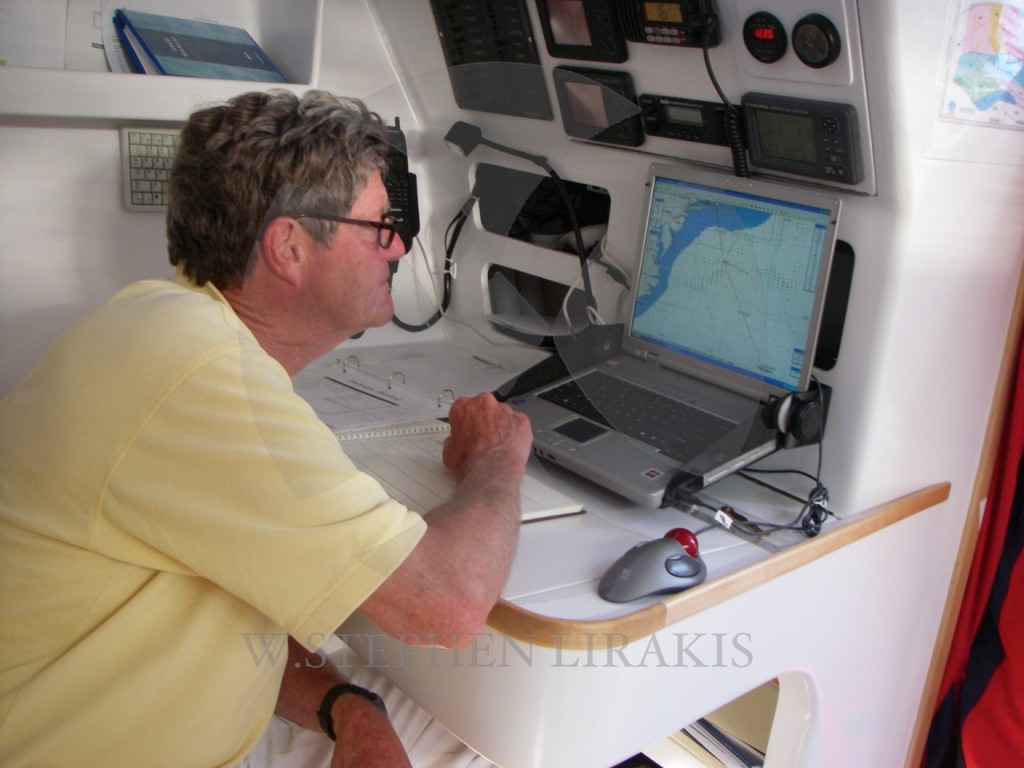
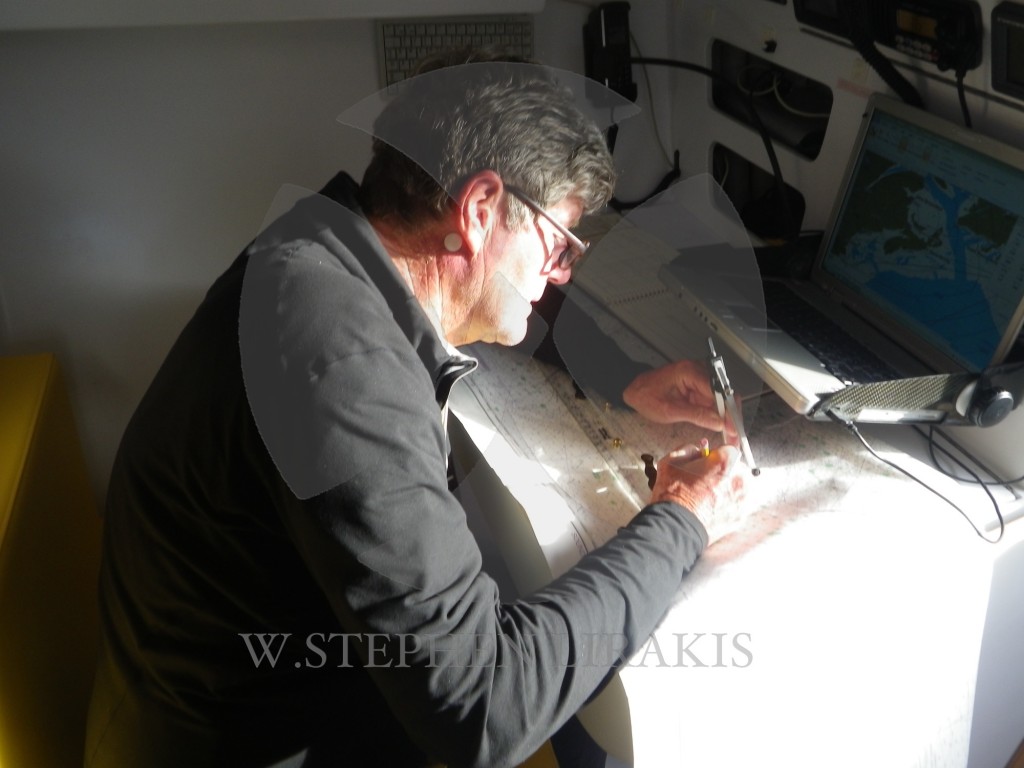
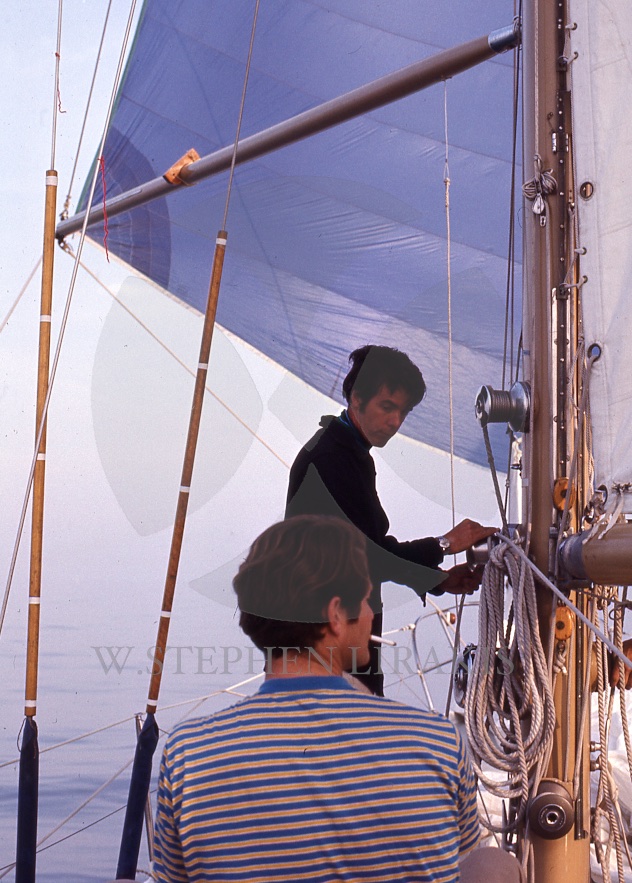
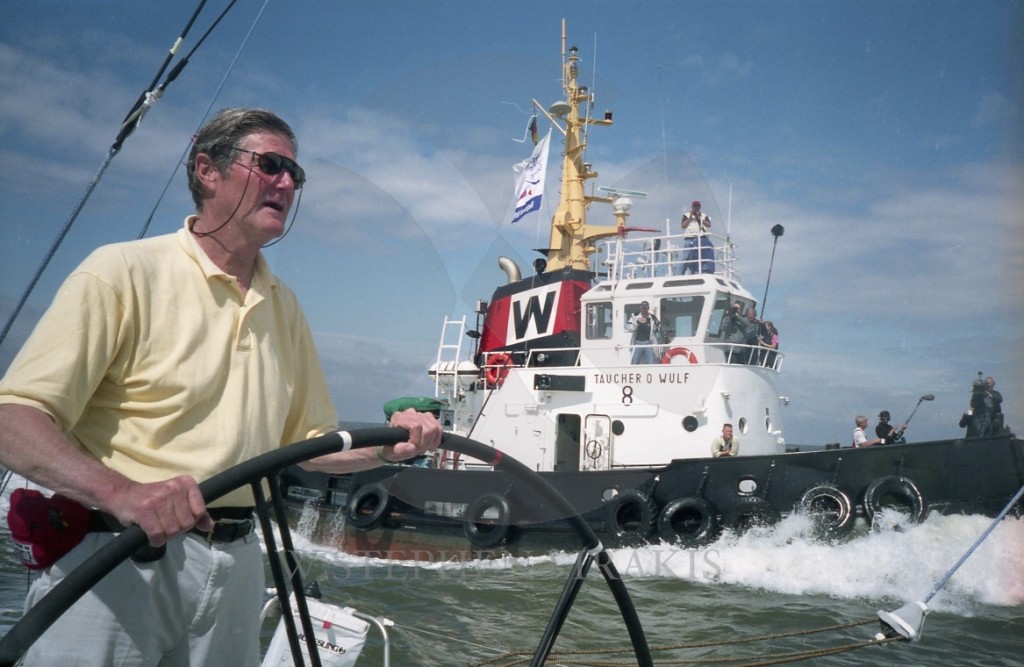
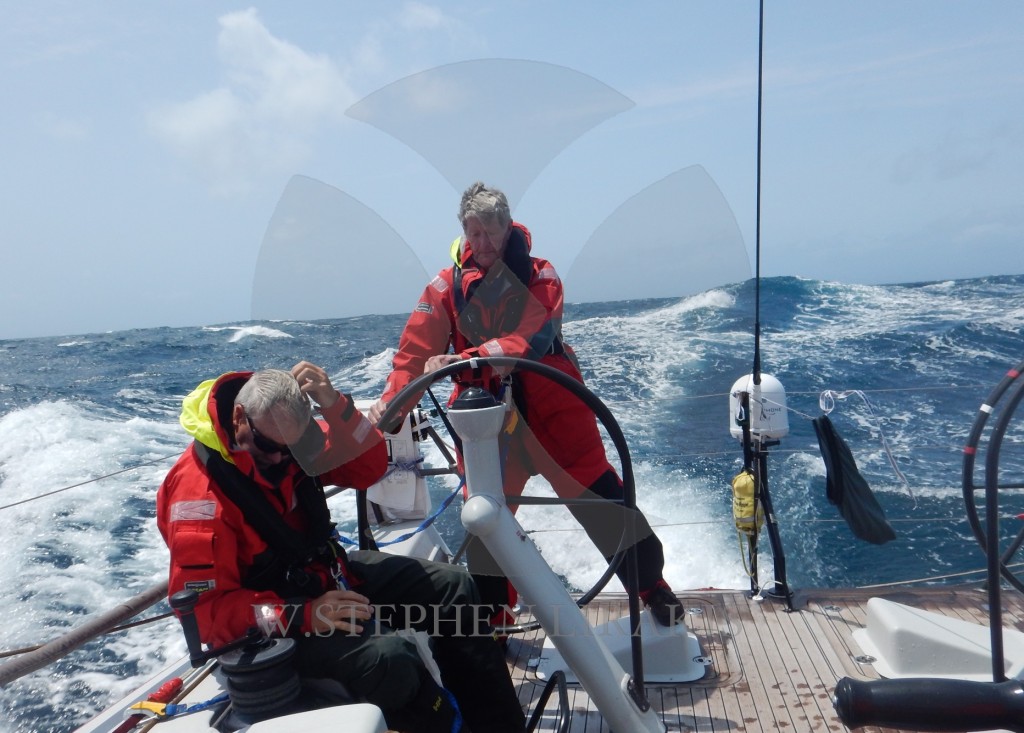
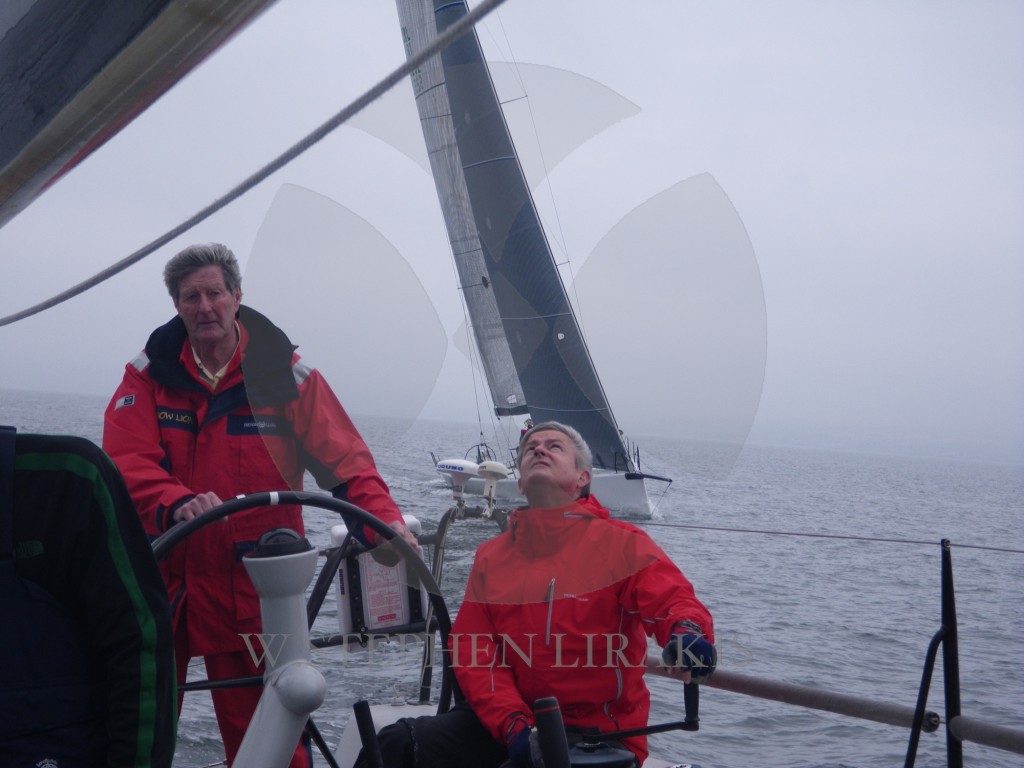
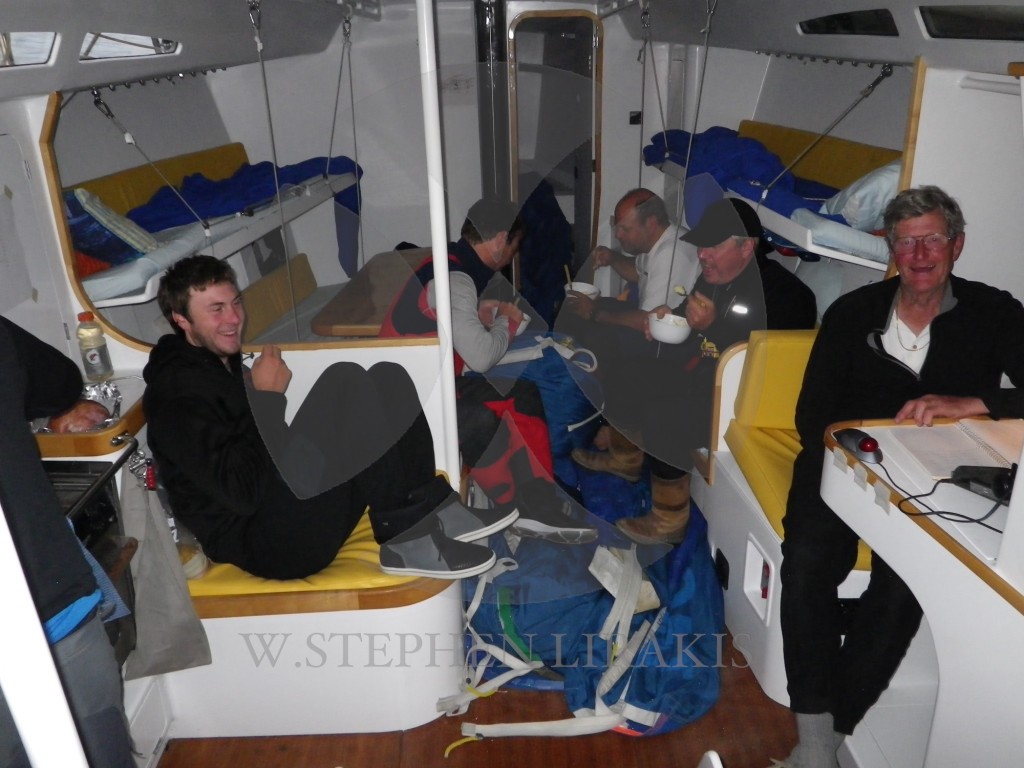
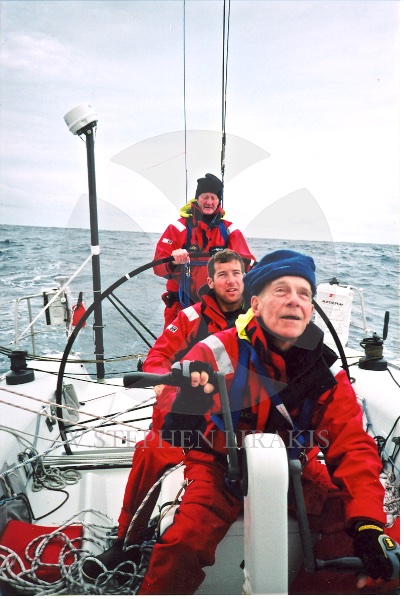
another look at the 2015 transatlantic race:
I crossed the Atlantic in 11 1/2 days this summer. For someone of my generation this was special. I never expect to repeat this experience. But I am still on a slow boat in today’s world.
The America’s Cup will never go back to non foiling boats. I still predict that the next Olympics will have at least one foiling class, if not two. No one is looking back, unless it is to true classic yachts. That is for different reasons of beauty and elegance.
The start for us is one month away.
“Geronimo” has been updated for Thomas Coville. Olivier de Kersauson set the bar high with “Geronimo” some years ago; setting records everywhere he sailed.
transatlantic race 2011 from ws lirakis on Vimeo.
A lot has changed in offshore sailing since Larry Huntington first raced across the Atlantic in 1957. Advances in yacht design, construction and materials have made the boats exponentially faster and more durable. Modern communications enable boats to remain in touch with other competitors and the rest of the world throughout the nearly 3,000-mile journey. But the essence of the adventure remains much the same.
“Going across the Atlantic is a fantastic change of pace from everyday life,” says Huntington, who is a former commodore of the New York Yacht Club, which will co-host the race with the Royal Yacht Squadron, in association with the Royal Ocean Racing Club and the Storm Trysail Club.
“It’s a chance to think about what Joseph Conrad wrote about the mystery of the sea. ‘The true peace of God begins at any spot a thousand miles from the nearest land.’ All of that goes through your head as you do this kind of adventure. It’s a wonderful time for reflection. It’s also intensely competitive. I find it all-consuming and enormously energizing.”
So it’s no surprise, that more than a half century after his first trip across the Atlantic, Huntington’s 50-foot Snow Lion was one of the first boats to enter into the 2015 Transatlantic Race, which will start from Newport, R.I., in late June and early July of 2015 and finish at Lizard Point, on the southwestern corner of England.
With 15 months until the first gun is fired from Castle Hill in Newport, R.I., more than 20 boats have entered and nearly 70 others have expressed interest. The fleet for 2015 is expected to reach its limit of 50 boats, nearly double the 26 boats that competed in the race in 2011.
“We’re extremely pleased with the significant early interest in this race,” says Royal Yacht Squadron’s Rear Commodore Yachting David Aisher. “The history of the transatlantic race dates back to the birth of recreational ocean racing in the late 1800s. More than a century later, it remains one of the ultimate tests of yachting skill.”
This will be the third Transatlantic Race for Snow Lion, a 50-foot boat designed by Jason Ker and built in 2006. There is an adage that says distance racers should never sail on any boat that is shorter in feet than their age. Huntington, who will be 80 when the race starts, clearly doesn’t subscribe to that theory.
“I had seen some of Ker’s previous designs and admired how they behaved and looked,” says Huntington. “We kept losing races to other Ker designs, so I figured [building one for myself] was a good thing to do.”
In 2011, it took Huntington’s team more than 15 days to complete the course. While that race was notorious for light and challenging wind conditions, the transatlantic course is still one of the longest regular races open to amateur sailors.
“First and foremost, you need a really compatible, competent crew,” says Huntington of the keys to success. “If you have full confidence in your shipmates, everyone gets the proper amount of rest and then you can address whatever Mother Nature wants to throw at you.”
Race website: www.TransatlanticRace.org
– See more at: http://www.sailingscuttlebutt.com/2014/04/01/offshore-racing-consuming-enormously-energizing/#sthash.NO8bexoc.dpuf
IN A QUEST TO PUSH OCEAN PASSAGE RECORDS INTO A NEW BENCHMARK, TECH GIANT JIM CLARK UNLEASHES A 100-FOOTER CURRENTLY DUBBED “NEWCUBED.”
 ENLARGE IMAGE
ENLARGE IMAGE
ONNE VAN DER WAL
CONSTRUCTION FOR JIM CLARK’S NEW 100-FOOTER IS UNDERWAY AT HODGDON YACHTS.
 ENLARGE IMAGE
ENLARGE IMAGE
ONNE VAN DER WAL
CONSTRUCTION FOR JIM CLARK’S NEW 100-FOOTER IS UNDERWAY AT HODGDON YACHTS.
CONSTRUCTION FOR JIM CLARK’S NEW 100-FOOTER IS UNDERWAY AT HODGDON YACHTS.
 ENLARGE IMAGE
ENLARGE IMAGE
ONNE VAN DER WAL
CONSTRUCTION FOR JIM CLARK’S NEW 100-FOOTER IS UNDERWAY AT HODGDON YACHTS.
 ENLARGE IMAGE
ENLARGE IMAGE
ONNE VAN DER WAL
CONSTRUCTION FOR JIM CLARK’S NEW 100-FOOTER IS UNDERWAY AT HODGDON YACHTS.
WHAT’S LENGTH GOT TO DO WITH IT? In the case of Jim Clark’s new ocean racer under construction at Hodgson’s Boatyard in Boothbay Harbor, Maine, quite a lot, or so says skipper Ken Read. Ken Read’s eyes light up when talking about Jim Clark’s newest ocean-racer project like a child at Christmastime who’s just unwrapped a Red Rider BB gun. The guilty pleasure lies in the fact that this is no ordinary 100-footer (if one can be ordinary). This yacht is designed to be a full-on record-breaker. You name the race or passage—Transat, Transpac, Bermuda, Fastnet, Hobart, to name but five—and it’s likely a target on their project whiteboard.
“This boat is going to be so cool,” says Read, Clark’s skipper and the President of North Sails who has experienced all types of campaigns—from J/24 World championships, to the America’s Cup and Volvo Ocean Race—in his decades-long experience in the sport. “This type of project isn’t for everyone, but it has a cool presence that will hopefully do the sport good, whether you’re a cruiser or a racer.”
Building a 21st century record-breaker is no small feat. It requires a plethora of designers to tank test scale models and run computer simulations, and there’s the “swat team” of boatbuilders to cook the pre-preg carbon-fiber hull and deck structures. All told, upwards of 32 people have contributed some input to the design and build through active participation or consultation. What will set this boat apart, says Read, is power, and lots of it.
THE BOAT WILL BE 100 FEET LONG WITH A DISPLACEMENT NEAR 30 TONS, BEAM IN THE MID-20S, AND A CANTING KEEL THAT WILL DRAW ALSO IN THE MID-20S.
They explored a lifting keel but determined it added too much drag for the desired upwind performance. Water-ballast tanks will aid stability, and fore and aft trim.
That makes it nearly identical in length, slightly lighter, and significantly wider and deeper thanWild Oats XI, the Reichel/Pugh maxi that has won line honors in the Rolex Sydney Hobart Race a record-equaling seven times. But with the mast stepped farther aft than Wild Oats XI, Read says Clarks’ yacht will look strikingly different.
“It’s going to be long, wide, and stable,” says Read. “With its power-to-weight ratio, there’s been nothing like it before. From a stability standpoint it’s a little stiffer, a little lighter, and with a little more sail area than Speedboat (the Juan Kouyoumdjian-designed 100-footer that’s now called Perpetual Loyal).”
FRENCH DESIGNERS
Clark’s as-yet unnamed yacht is from two French design firms, the renowned duo of Marc Van Peteghem and Vincent Lauriot-Prévost (VPLP), along with new star Guillaume Verdier. VPLP’s track record designing multihulls is second to none. Their designs include the giant multihullsGroupama 3 and Banque Populaire V. Groupama 3 measured 103-foot LOA and shattered records such as the 24-hour, Transatlantic, and Trophée Jules Verne, only to see those records fall – in the case of the 24-hour record just one day later – to the 130-foot long Banque Populaire V. Verdier, meanwhile, had more concentration on shorthanded monohulls in the 40- to 60-foot range.
In 2007 the two firms joined forces to take on the highly competitive IMOCA racing circuit, for singlehanders in 50- and 60-footers, and they’ve had great success ever since, capped by stunning performances in the 2012-’13 Vendée Globe singlehanded non-stop race around the world. VPLP-Verdier designs placed 1-2 and took three of the top four overall. And they were fast: The race-winner, Macif, set a new, ratified 24-hour singlehanded distance record of 534 nautical miles at an average speed in excess of 22 knots, and the first two yachts completed the circumnavigation in less than 80 days.
“No doubt, this new boat is a development of Macif,” says Read. “The scale of a project like this, from an engineering and structural standpoint, is nothing like that boat. But the designers took shapes they liked from the IMOCA 60s and developed from there.”
Macif, however, was designed as a horse for the course. Racing around the world is more about close reaching or off-wind sailing. Clark’s new yacht will have upwind capabilities that could be necessary in short offshore races, those of 600 to 1,000 nautical miles. It will have two rudders, but the weather rudder won’t be lifted out of the water because rating rules prohibit such features. Clark’s yacht also won’t have the cut-back rail that Macif sported along its sheerline and which made the hull appear like an ellipsoid. The crew of around 20 (still being determined) requires a rail on which to hike.
FEWER CREW; MORE TO DO
The surprising part in all of this is that the yacht’s winches will be manually powered. Six pedestals will be mounted with custom bevel boxes to create specific gear ratios for the power necessary to trim the enormous sails. Read said the sail plan is still being finalized, but the A5 gennaker could measure in close to 1,000 square meters. The gennaker for Alinghi 5, the catamaran that contested the 33rd America’s Cup, was reportedly one of the three largest ever built at 1,100 square meters. And that cat had powered winches.
“Keep in mind that Banque Populaire V went around the world with no push buttons, about 50 percent more righting moment, and the same size rig as this boat, with one less pedestal,” said Read. “We did a study and found that we can produce as much or more power to the winches with 12 guys grinding than with push buttons. With manual winches, if we do a Transatlantic we can save up to a ton and a half of fuel and won’t have to keep the engine running all the time. Also, if we set a record it won’t have an asterisk next to it because of the powered winches. It’ll just be more fun to sail.”
It certainly will be fun to sail according to the VPPs. Upwind the boat is projected to sail at 13 knots, but at its sweet angle, about 120 degrees true wind-angle in 25 knots of wind, it’s predicted to average 30 knots.
One feature Verdier changed after testing five models at the Wolfson Unit in Southampton, England, was the bow profile. Macif has a very full bow, and initially that was the look for Clark’s new yacht. “Designers have poked around the concept of full bows for a while now. A boat like Macif or the VO70 Abu Dhabi were full bows,” says Read. “Verdier was much higher on the concept before the tank tests, and I think the bow got considerably narrower.
“It’s more specific to upwind performance than anything,” Read continues. “We think we’re coming up with ways to get the bow out of water when planing off the wind. Other concepts such as keel and daggerboard placement will help lift the bow, so we aren’t using as much volume forward to lift the bow. It’s not a narrow bow but not a full bow. It’s probably more conventional than any other boat.”
STRUCTURE AND SAIL PLAN
As of this writing the outer skin of the hull had just been laid up and the hand-selected work force at Hodgson’s Boatyard, led by Tim Hackett and Brandon Linton (the duo helped build Read’s two Puma-branded VO70s) was beginning to install the bulkheads. Read says that the yacht will be compliant with scantlings established by Germanischer Lloyd, the marine classification society based in Germany that strives to ensure safety at sea. There will be bulkheads every eight to 10 feet, and the boat is expected to pass the 135-degree vanishing stability test. While the sail plan is still in development, Read says there’ll be nine or 10 sails total. Aside from the mainsail and J2, the 100-percent headsail that will be hanked on, all other headsails will fly on roller-furlers and from custom stays. The headsails are all just different shapes of genoas or gennakers. There are no spinnakers on the boat because the apparent wind angle isn’t expected aft of 65 degrees. The material of choice is 3Di except the downwind sail, which is cuben-fiber.
“Sail area and mast height are all pretty darn similar to what Speedboat was,” said Read. “It’s fascinating how little horsepower you need. Once it starts building its own apparent wind, you almost can’t get the sail area off fast enough.”
With the mast so far aft in the boat, says Read, it’s quite possible the sail plan will extend beyond the transom.
“Where the sail plan sits over the platform is very different, almost more like *Banque Populaire V,” says Read. “There’s nothing that says the boom can’t hang off the back of the boat or that the traveler has to be in the middle of the cockpit. Nothing says the sail plan has to be forward in the yacht.”
ABOUT THE RECORDS
Quick quiz: What monohull currently holds the crewed west-to-east transatlantic record and when was it set? This writer was amazed to see that Mari-Cha IV, Robert Miller’s powerful 140-foot ketch is still the record holder. In October 2003, a crew of 24 took Mari-Cha IVacross the Atlantic in 6d:17h:21m at an average speed of 18 knots. The maxi catamaranBanque Populaire V holds the outright record at just over three and a half days, an average speed just shy of 33 knots, but Mari-Cha’s mark still stands some 10 years later.
Ken Read pulled no punches when saying that the Transatlantic record is among the marks he hopes to slay with Jim Clark’s new 100-footer. “The goal of this boat is to break records and be first to finish in the classic offshore races,” says Read. “This boat isn’t for around the buoys. The deck layout isn’t set up for it and the draft is too deep. We want to tick off every major race.”
They’ll get their first crack at a record later this year when they enter the Rolex Sydney-Hobart Race, where they’ll expect to encounter Bob Oatley’s Wild Oats XI, the seven-time line honors winner.
After the Hobart, other classic races on the radar include the Newport-Bermuda, Fastnet, Transpac, the Middle Sea Race, the Pineapple Cup (Miami to Montego Bay), and the Caribbean 600. Besides those and the Transat, they also plan a crack at the 24-hour record of 596 nautical miles set by Ericsson 4 in the 2008-’09 Volvo Ocean Race. And for the cherry on the cake, they might even attempt the non-stop, round the world mark. Banque Populaire V also holds that outright record, at 45-and-a-half days. The WSSRC doesn’t list a crewed monohull outright record (the round-the-world monohull records are singlehanded), but Read thinks they could do it in 55 days, give or take. “You don’t build a boat like this without throwing something like that on the table,” says Read. “We did a 42-day leg in the Volvo one year, so 55 days around the world isn’t too bad.”